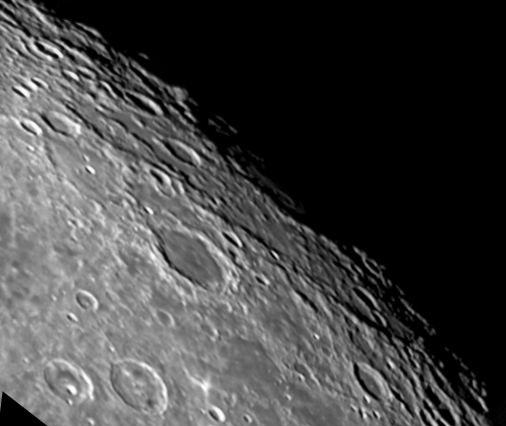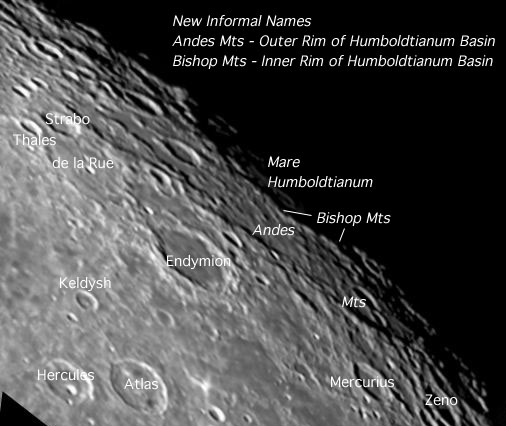Difference between revisions of "October 30, 2004"
| (7 intermediate revisions by the same user not shown) | |||
| Line 1: | Line 1: | ||
__NOTOC__ | __NOTOC__ | ||
=Another Basin on Another Limb= | =Another Basin on Another Limb= | ||
| + | <!-- Start of content --> | ||
<table width="85%" border="0" align="center" cellpadding="6" cellspacing="2"> | <table width="85%" border="0" align="center" cellpadding="6" cellspacing="2"> | ||
<tr> | <tr> | ||
| Line 30: | Line 31: | ||
<br>Rukl <i>Atlas of the Moon,</i> Sheet 7 | <br>Rukl <i>Atlas of the Moon,</i> Sheet 7 | ||
</p> | </p> | ||
| − | <p | + | <p><b>Yesterday's LPOD:</b> [[October 29, 2004|Unscrunching Orientale]] </p> |
| + | <p><b>Tomorrow's LPOD:</b> [[October 31, 2004|Sunrise and Sunset on the Triade]] </p> | ||
</tr> | </tr> | ||
</table> | </table> | ||
| Line 41: | Line 43: | ||
<p align="center" class="main_titles"><b>Author & Editor:</b><br> | <p align="center" class="main_titles"><b>Author & Editor:</b><br> | ||
[mailto:tychocrater@yahoo.com Charles A. Wood]</p> | [mailto:tychocrater@yahoo.com Charles A. Wood]</p> | ||
| − | < | + | <!-- Cleanup of credits --> |
| − | + | <!-- Cleanup of credits --> | |
| − | < | + | <!-- Cleanup of credits --> |
| − | + | <!-- Cleanup of credits --> | |
| − | + | <!-- Cleanup of credits --> | |
| − | < | + | <!-- Cleanup of credits --> |
| − | < | + | <!-- Cleanup of credits --> |
| − | + | <!-- Cleanup of credits --> | |
| − | < | + | <!-- Cleanup of credits --> |
| − | + | <!-- Cleanup of credits --> | |
</td></tr> | </td></tr> | ||
</table> | </table> | ||
<p> </p> | <p> </p> | ||
| − | ---- | + | <!-- End of content --> |
| − | + | {{wiki/ArticleFooter}} | |
| − | |||
Latest revision as of 12:49, 22 March 2015
Another Basin on Another Limb
Image Credit: Dave Nash |
|
Another Basin on Another Limb It's not fair! On the Earth-facing side of the Moon only two impact basins have significant rim segments - Imbrium and Nectaris. But just over the western limb is Orientale, one of the most complete basins in the solar system, and on the NE limb is Humboldtianum, another basin with significant preserved rims. What's even less fair is that most of these basins have named rims: the Apennines, the Caucasus, the Altai, the Cordillera and the Rook. But as shown in Dave's excellent image, the inner and outer rings of the Humboldtianum basin are quite prominent, yet they are unnamed. I hereby propose some informal names for these rings to ease discussion of them. Following the common habit of naming lunar mountains after terrestrial mountains, I propose that the 650 km wide outer ring of the Humboldtianum basin be named the Andes Mountains, which reflects Alexander von Humboldt's exploration of this South American range. And since the inner ring of the Orientale basin is called the Rook Mountains, for symmetry (and thinking back to my chess playing days), the 340 km diameter inner Humboldtianum ring is here named the Bishop Mountains. Now all that is needed to really appreciate these rings is a rectification of this image! Technical Details: Related Links: Yesterday's LPOD: Unscrunching Orientale Tomorrow's LPOD: Sunrise and Sunset on the Triade |
|
Author & Editor: |
COMMENTS?
Register, Log in, and join in the comments.





